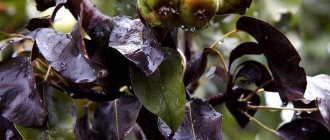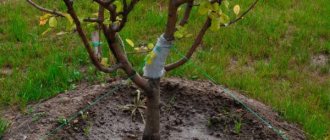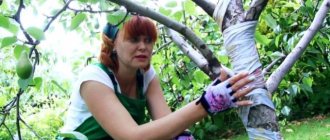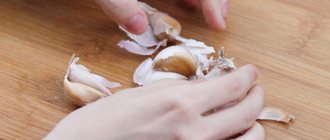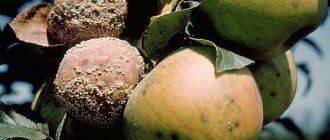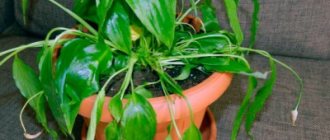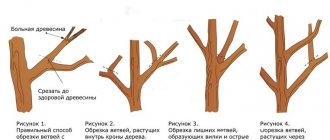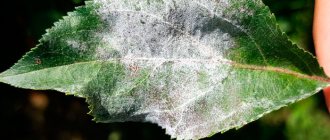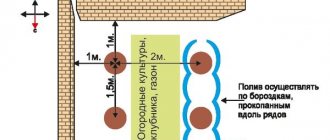Studying the enemy
Black apple canker is a highly harmful fungal infection, which is popularly called “Anthony's fire” or “fireworm”. Many types of fruit trees are susceptible to this disease, but apple trees are most often affected.
Infection with black cancer occurs in the spring. Spores can overwinter in fallen leaves, rotten fruit, and even in the folds of healthy tree bark. When suitable weather conditions occur, awakened spores, falling into fresh damage on the tree, begin to grow in the intercellular space of tissues, causing the death of plant cells. After this, the fungi continue to develop as necrotrophs, feeding on the dead remains of the plant.
What are the signs for diagnosing the disease?
As the disease develops, unusual symptoms may appear on different parts of the apple tree. The tree begins to wither and shed its leaves.
Bark
If wounds and cracks are found on the trunk, they should be examined carefully. With cancer, black dots are located in circles around the wound.
With the active development of infection, signs are easily distinguished. The bark is covered with deep depressions of purple and black shades. The affected area becomes deformed and cracks.
Flower
During the flowering period, a sign of cancer will be a change in the appearance of the inflorescences. The petals are covered with brown spots and stripes. Inside, the inflorescence begins to turn black and twist.
Fetus
Small brown spots begin to appear on the fruits, which gradually become larger. The sign becomes noticeable only when the fruits enter the ripening stage.
As a result, the entire inside of the apples rots and they fall to the ground. Not all bad apples fall. Even after the leaves have completely fallen, black, wrinkled fruits hang on the branches.
Sheet
Already when the leaves bloom in spring, spots become noticeable on the leaves. At first, the spots are small in size with a brown-red tint. As the disease progresses, the spots grow and become darker. The leaves dry out and fall off. The tree begins to abruptly shed its leaves long before the onset of cold weather. As a result, the quality of the crop decreases. The fruits rot and are poorly stored.
Optimal conditions for infection
Warm, rainy weather in spring is favorable conditions for the germination of spores that cause apple tree cancer. April-May are potentially dangerous months for an orchard, since rising air temperatures, heavy rainfall and damp soil due to melting snow are a suitable environment for the development of any fungal infections.
Black cancer on an apple tree.
Positive temperature
Temperatures from +5 degrees and high humidity contribute to the awakening of spores. The higher the air temperature, the higher the rate of spread of the fungus in healthy tissues.
Poor quality trees
Typically, trees that become sick are old, exhausted, and also those injured during winter (frozen, damaged by rodents). In this case, the tree does not have enough strength to form immunity and quickly regenerate damaged tissue.
The stronger the bark, the less chance the fungus has to penetrate the tissue.
Incorrect care or lack thereof
Lack of preventive treatment of trees against fungal diseases also leads to infection with black cancer. In addition, the cause of the disease can be improper pruning, untreated areas of cuts and cuts. An open wound is a favorable condition for the penetration of pathogens.
Excessive grooming
Excessive care can also cause the spread of fungal infections in the garden. Excessive nutrient content in the soil favors the development of pathogenic microflora.
Incorrect landing
Factors that increase the risk of fungal infection that must be taken into account when planting:
- excessive deepening of the root collar;
- the distance between the trees and the compost pit is less than 3 m (actively decomposing organic matter can become a “shelter” for pathogenic microflora and a source of infection);
- poorly drained area with stagnant water;
- placing trees too close to each other leads to the rapid spread of the pathogen throughout the garden.
Description of the disease
The causative agent of black cancer is a marsupial fungus (Sphaeropsis malorum Peck), belonging to the Botryosphaeriaceae family. Spores of a pathogenic fungus penetrate into the tree through various surface damage, parasitizing not only living but also dead tissue. Old apple trees over 20 years old are most susceptible to this infection.
The mycelium of the fungus overwinters in the tree bark, and in early spring wind, rain and insects spread it throughout the garden.
The disease received the name “black cancer” due to the characteristics of its course, similar to the formation and development of a cancerous tumor, that is, the intensive division of pathogenic cells, which contributes to the death of living tissues of any organism.
Favorable conditions for infection
The optimal conditions for the activation of fungal spores are elevated temperature and humidity. Potentially dangerous months for apple trees are April and May, since the soil, which is still damp after the snow melts, provides the fungal infection with an environment suitable for development.
Air temperature
The pathogenic fungus exhibits maximum viability at temperatures ranging from +22 to +28 °C and humidity levels up to 80%.
In such conditions, harmful microorganisms will need no more than 6 hours to fully mature. Due to its high vitality, the causative agent of black cancer does not die even at temperatures up to +40 ° C.
Low immunity
Old apple trees, as well as those weakened by insufficient care, are almost unable to resist infection, so it affects them first.
Having penetrated the woody tissues of old trees, the mycelium actively reproduces, quickly spreading throughout the garden. Young and strong specimens are more resistant to the disease, and the rapid regeneration of their tissues prevents fungal spores from entering the wood. The young age of trees and adherence to basic agricultural practices do not provide one hundred percent protection against black cancer, but significantly reduce the likelihood of its development.
Failure to comply with agrotechnical principles
Improper pruning, neglecting wound treatment, allowing the crown to become excessively thick - all this contributes to the damage to trees by black cancer. The disease also poses a high degree of danger for crops affected by pests, as well as fungal and bacterial diseases: powdery mildew, scab, etc. Lichens and mosses that have settled on trees stimulate the development of infection, providing it with warm and humid conditions.
Consequences of over-grooming
Abuse of fertilizers leads to their excessive accumulation in the soil, which creates a breeding ground for fungal infections.
Errors during landing
Insufficient distance between apple trees accelerates infection of the orchard.
Due to limited space, many gardeners prefer compacted planting. In this case, their regular inspection and enhanced care will reduce the likelihood of crops becoming infected. It is unacceptable to grow fruit trees near toilets and compost pits - places of active decomposition of organic matter; the optimal distance from them is 3 meters or more.
The following factors also increase the risk of black cancer:
- planting too deep (deepening of the root collar);
- stagnation of water in the area caused by insufficient drainage.
How to recognize
The initial stage of the disease may be asymptomatic and only after a week or even a month will signs of black cancer appear. Having discovered the first signs of black cancer on an apple tree, begin treatment immediately.
Bark
Damage to tree bark is especially dangerous. In this case, the tree dies completely within 3-4 years. The incubation period for bark infection is 15-27 days.
Black cancer on the trunk of an apple tree.
In early spring, you need to carefully examine the trunk and skeletal branches of trees. First of all, you need to make sure the integrity of the bark. If you find any fresh wounds on the wood, you need to examine each damage in detail. If infection has occurred, the wound will be surrounded by black dots (pycnidia) arranged in circles.
The fungus is growing rapidly. The active phase of the disease is characterized by the appearance of black spots with a purple or brown tint. Destructuring of the bark occurs, it peels off and crumbles. Damaged areas become charred. Eventually, the dead tissue encircles the skeletal branches and trunk of the tree.
Flowers
When apple tree flowers are infected with black cancer, the petals acquire a brown tint, become shriveled and dry out. The stamens and pistil turn black.
Fruit
Mostly mature fruits are susceptible to infection. When fruits are infected, the incubation period lasts 6-9 days. Then dark spots appear that grow throughout the fruit. The apple shrivels and mummifies. The color of the fruit is black without any shade or brown.
Leaves
On the foliage, the fireweed appears in the form of red-brown spots. After a while, the center of the spot turns gray and circles appear around it. Then the number of spots increases, the leaves begin to dry out and fall off. In 1.5-2 months, a diseased tree can completely lose its foliage.
Disguise
Black cancer successfully masquerades as other diseases. It can be confused with diseases that cause similar damage. Therefore, before you start fighting black cancer on an apple tree, carefully study all the symptoms of the disease that appear. If you remember the main differences between the manifestations of these diseases, you will be able to correctly diagnose the disease and begin its treatment:
- cytosporosis leaves gray spots on the bark, which subsequently do not turn black (i.e., there is no charring effect);
- With cytosporosis, the bark does not crumble, but takes on a worn-out appearance;
- with ordinary cancer, swellings and tumors with dark red tubercles form on the cortex;
- Moniliosis, like fireweed, colors the fruits black, but with a blue tint.
Black cancer often occurs simultaneously with other fungal infections.
Apple tree with traces of black cancer.
General characteristics of the disease
Black crayfish, or fireweed, is the result of the spread of a fungus of the Botryosphaeriaceae family. The disease owes its name to the species that the affected fruit tree acquires. Where fungal spores accumulate, the bark and exposed wood appear charred. The disease can threaten any fruit trees, but apple trees most often suffer from it. The danger of the disease lies in the rapid spread of infection - spores are carried by precipitation and wind.
At risk of damage are primarily weakened and old apple trees with reduced immunity, unable to fight infection.
Moss and lichen covering old trees are an ideal breeding ground for the causative agent of black cancer
The fungus enters the tree through bark that is damaged or cracked due to age. It becomes active with the onset of heat. The temperature at which spores begin to germinate is 16–27°C. They overwinter in pycnidia (fruiting bodies of the fungus) on mummified infected fruits and in tree bark.
What defeat looks like
The first symptoms of black cancer can be seen in early spring on the trunk and skeletal branches. Small indentations with a reddish-brown center appear on the bark. This is the initial stage of an ulcer. As it grows, the bark turns black, as if charred, cracks and falls off. The wood under the fallen bark also becomes jet black. Gradually, the fungus invades new areas, encircling the trunk and branches, depriving the tree of nutrition and leading to the complete death of the crown.
When a colony of fungal spores grows strongly, the bark takes on the appearance of charred wood.
Leaves and fruits also show signs of the disease. Purple dots appear on the upper side of the newly blossoming leaves. Then these spots begin to grow, reaching 3–6 mm. After some time, spots appear on the leaves in the form of rings with black convex dots. This is where pycnidia are formed.
Summer leaf fall is one of the signs of black cancer; it threatens a lack of fruiting and a difficult winter (the apple tree can die from frost).
On fruits, symptoms of the disease do not appear immediately, but only when the apples reach medium size. At first, the defect looks like a shapeless reddish spot. Over time, the spots darken and become purple with a red border.
The initial stage of cancer appears on fruits in the form of shapeless spots
Gradually, the rot spreads, taking the form of concentric rings of dark brown or black color. Their surface is covered with pycnidia. Such fruits become mummified and often do not fall off, but remain on the branch.
Risk factors
Sometimes gardeners themselves create conditions favorable for trees to become infected and the infection to spread. Recently, so-called intensive gardens with dense planting of trees have become popular. The close distance between them increases the risk of infection of the entire garden. Other risk factors:
- Planting apple trees near places where organic matter is actively decomposing (compost pit, toilet).
- Excessive organic and mineral fertilizing. Accumulating in the soil, these substances create an excellent environment for the development of pathogenic fungi.
- Poor care and improper pruning. An injured cortex is an open gate for infection.
Weather conditions also play a role in the spread of the disease. This is facilitated by frequent rain and wind.
How to cure an apple tree from black cancer
If a lesion with damage characteristic of the final stage of a cancer infection is located on a trunk or skeletal branch, the tree is removed. Because it is impossible to cure a dying apple tree from black cancer. In other cases, it is possible and even necessary to treat the tree.
Cleaning
Before you start treating apple tree cancer, you need to sanitize the trees and the area:
- remove infected foliage and fruits;
- cut down infected branches;
- Apple trees with critical damage must be uprooted;
- burn infected parts in a specially designated place.
Operations on apple tree trunk bark and skeletal branches
Skeletal branches, completely surrounded by cancerous tissues, are cut down entirely below the place bordering healthy tissues. Topical lesions on the branches or trunk are cut out, capturing some healthy tissue.
Cleaning the trunk of an apple tree from black cancer.
After the manipulations have been carried out, you can proceed directly to the treatment of black cancer in the apple tree.
Disinfection and isolation of the wound
All cuts obtained during wood sanitation must be immediately disinfected. A 1-3% solution of copper sulfate or a concentrated solution of potassium permanganate is suitable for this purpose. Then the wound is “sealed” with garden varnish or special oil paint to prevent the entry of air and moisture, which can trigger a relapse.
Apple tree processing
Since firefly is spread by spores, sanitizing the tree alone will not be enough. All parts of apple trees are susceptible to cancer infection, so the entire tree needs to be sprayed with fungicide.
Garden treatment
Since we have to fight apple tree cancer in a comprehensive manner, all fruit crops in the garden must be treated with fungicides. In addition, it is advisable to treat the soil in the tree trunks with antifungal drugs.
Folk remedies
Some believe that the use of “chemicals” harms not only the environment, but also the person himself. Therefore, there are always enthusiasts offering various folk remedies as an alternative to chemistry.
The following can be used as disinfectants:
- iodine-saline solution;
- a solution of ordinary 72% laundry soap;
- ground sorrel leaves mush;
- concentrated manganese solution.
With potassium permanganate you can not only disinfect saw cuts and cuts, but also wash the entire tree to wash off pathogenic spores from it.
A mixture of clay and mullein
Instead of garden varnish and other special means for treating wounds, you can use folk recipes.
Clay and cow dung are mixed in a 1:1 ratio, water is added to obtain a viscous consistency, convenient for spreading. The mixture should be of medium thickness so that it does not clump or spread.
The resulting mixture is applied in a very thick layer to cleaned, disinfected wounds, bandaged and again covered with a thick layer. Throughout the growing season, the coating is regularly moistened with water and additionally lubricated with fresh mixture.
A mixture of rosin, wax and nigrol
If nigrol is somehow preserved among the old supplies at the dacha, you can prepare a putty based on it. To do this, you need to heat nigrol, rosin and wax (paraffin) in a 1:1:1 ratio in separate containers. Pour rosin and wax into the hot negrol and mix thoroughly. The resulting putty can be stored in glass jars and used as needed.
This mixture is used as a regular garden varnish.
Treatment of apple trees for black cancer.
garden soil
Some gardeners use garden soil pre-treated with a fungicide as a putty. The soil is moistened and the disinfected wound is coated with it. After rains, the procedure is repeated.
Apple tree bark
Particularly advanced gardeners use the following method:
- A piece of bark is cut from a healthy donor tree, the shape exactly suitable for closing the treated wound on the apple tree.
- The bark is tightly applied to the wound, aligning all the edges, and bandaged.
- All joints and cuts are carefully covered with garden varnish.
Research results
Foreign and domestic breeders are constantly studying the most dangerous diseases in order to develop effective measures to combat them and develop new varieties with increased resistance. VNIISPK specialists conducted field studies, during which the reaction of apple trees with black cancer to health-improving measures was assessed. Adult naturally infected trees of the varieties “Orlik”, “Sinap Orlovsky” and “Orlovskoye Polosatoe” were selected for observation. Their treatment was carried out according to the following scheme:
- On diseased apple trees, the wounds were cleaned, including 2-3 cm of healthy wood.
- The damage was treated with a 3% solution of copper sulfate and covered with garden pitch.
- The cut bark was burned.
- In the fall, at the end of October - November, tree trunks were covered with garden whitewash.
For therapeutic measures, it is better to choose dry sunny days, when the cut bark will burn well and the whitewash will dry quickly and last longer on the surface of the trunks
Studies have shown that trees respond well to stripping damaged tissue in the spring and whitewashing the trunks in the fall. The Orlovskoye Polosatoye variety turned out to be more susceptible to this fungal disease, and it took longer to treat it. "Orlik" and "Sinap Orlovsky" showed fairly high resistance and responded better to treatment. The effect of the measures taken was observed for at least three years - healthy trees showed good growth, increased yield, and improved appearance of fruits.
Additional treatments for black cancer
In the fight against black cancer and other fungal diseases of fruit crops, gardeners often use a very strong manganese solution. It has excellent antibacterial and antifungal properties.
To treat wood against fungal spores, potassium permanganate is diluted with water (5 g per 10 l) in a glass or plastic container. The resulting solution is used to treat not only wounds, but also the entire bark on the trunk and branches. In this case, you need to literally saturate the bark with the solution, washing away the spores. After washing the wood, spray the leaves and fruits.
Treatment of apple tree cancer with antibiotics
This method is used in industrial gardens in Europe, since it is believed that antibiotics are more environmentally friendly drugs than chemicals.
Antibiotics such as streptomycin and tetracycline are used for treatment. Treatment consists of sequentially spraying the garden with a solution. Spraying begins with streptomycin, and next year it is replaced by tetracycline.
Stem injections
Injection treatment does not require preliminary sanitary treatment of the diseased apple tree; you simply need to treat the tree with fungicides. Injections are made by introducing the antibiotic streptomycin into the wood of the trunk:
- A hole is drilled in the bark of the apple tree a meter from the ground, through which the antibiotic is injected.
- After administering the drug, the hole is sealed with a stopper.
- Each skeletal branch thicker than 15 cm is taken as a separate trunk, into which an antibiotic is also injected.
- The medication is administered weekly, up to five times in total.
Treatment of an apple tree for black cancer with stem injection.
Unfortunately, antibiotics only help get rid of bacterial types of diseases, which black cancer does not include. But this method will definitely help get rid of other diseases that often develop in parallel with black cancer.
Drugs for fighting
Drugs used in the treatment of black cancer of apple trees are conventionally divided into three groups:
- for disinfection (antiseptic treatment of wounds with industrial preparations) – garden paste “RanNet”, biobalm “Robin Green”, garden anti-cancer putty “ZSP”;
- for treatment against spores (preparations of contact and systemic action, used for spraying the crown and soil) - “Fitosporin”, “Chorus”, “Topaz”, etc.;
- to improve immunity (“Baikal EM1”, “Zircon”, “Gumat P”, “Obereg”, “NV - 101”, etc.).
Copper-containing drugs
Preparations containing copper are used to disinfect wounds; they can also be sprayed on trees, because copper has a depressing effect on fungal spores. In addition, copper sulfate is used to enrich the soil with microelements.
Due to its versatility, copper sulfate is included in many popular gardening preparations for various purposes. The most popular are “Bordeaux mixture”, “HOM”, “Oxychom”, etc.
Feeding
To speed up the healing process, apple trees need to be fertilized with mineral fertilizers. Organics cannot be used in this case, because its presence in the soil can provoke a relapse of the disease.
Treatment with antifungal drugs for humans
You need to immediately understand that fungal diseases of plants and people have different etiologies, so medications for treating human fungus cannot affect plant fungus. There is no point in treating apple trees with human antifungal drugs and expecting a positive result.
Symptoms of disease development on a tree
If you do not start fighting, pycnidia will eventually appear on the trunk of apple trees. They are the body of the mushroom itself; several of them can form on one tree. These growths are a sign of the final stage of development of black cancer.
Under the influence of infection, leaves fall shortly before the apples ripen. It is clear that this reduces the yield of the tree, and the fruits themselves stop growing and rot. This destructive process begins with the appearance of small brown spots on the apples. Then they increase in size and can cover the entire apple.
Treatment time for black cancer
Operations should be planned for early spring or late autumn, when the sap flow process is as slow as possible:
- In the spring, before mid-April, it is necessary to carry out sanitary pruning and treat the wounds of the apple tree. Afterwards, before the buds open, treat the trunk and crown with a fungicide. After flowering, the apple tree is subjected to repeated antifungal treatment.
- In the autumn, after leaf fall, sanitary treatment is carried out by pruning fungus-affected branches and cleaning wounds. All sections are treated with an antiseptic and sealed. After sanitation, the trees are sprayed with fungicides, the trunk and skeletal branches are whitened.
Chemical and biological agents
Treatment of black cancer in apple trees involves the use of drugs aimed at destroying fungal spores and increasing the tree's immunity.
Copper-containing products are suitable for disinfection, have a detrimental effect on the development of the infectious agent and act as a fertilizing supplement.
The vegetative part is sprayed:
- copper sulfate;
- Bordeaux mixture;
- complex substances: Khom, Kuprostat, Tsikhom, etc.
To spray the soil and crown, contact and systemic preparations with fungicides are used, which simultaneously affect the cancer pathogen, fungal and bacterial infections and pests:
- Topaz;
- Fundazol;
- Horus;
- Impact;
- Topsin-M;
- Funaben;
- Strobe and similar.
Fungicides preserve the vitality of trees.
Compositions of biological effects, made on the basis of the vital activity of bacteria, are included in putties or in solutions for soaking clay, mullein and garden soil (Gamair, Alirin, Fitoporin).
Prevention
For prevention, it is necessary to follow several rules of agrotechnical measures:
- timely pruning of trees to prevent thickening of the crown, timely treatment of cuts and wounds;
- maintaining distance when planting apple trees to avoid the rapid spread of the disease if infection does occur;
- mandatory balanced feeding - apple trees that are fertilized correctly and in a timely manner have good immunity to various types of diseases;
- proper preparation of the garden for wintering: cleaning and removing debris from tree trunk circles, mandatory whitewashing of trunks and skeletal branches to protect against sunburn;
- organizing drainage systems to prevent moisture from stagnating in the soil near the tree trunks.
Preventive treatment of apple trees against black cancer.
Similarities with other diseases
Black cancer can be confused with other diseases that have similar symptoms. In order not to be mistaken when diagnosing the disease and to choose the right treatment method, it is important to know the main differences between these ailments:
- Cytosporosis is the appearance of gray spots on the bark that do not subsequently turn black and do not resemble charring. The bark does not peel off, but due to a change in structure it takes on a worn-out appearance.
- Common cancer is the formation of nodules with dark red bumps on the surface of the bark.
- Moniliosis is the acquisition of black fruits with a blue tint.
Often, at the same time as black cancer, other infections also affect the apple tree.
Adviсe
Here's what experienced gardeners advise:
Diana: “It is easier to prevent any disease than to try to cure it later. Therefore, provide proper care to your apple trees and prune them in a timely manner with disinfected garden tools, so as not to transfer the infection from sick trees to healthy ones.”
Anatoly: “Black cancer is curable, I know from my own experience. The main thing is to detect the disease in time and begin treatment, and then take mandatory recovery measures.”
Resistance to infection
When choosing a variety of apple trees to grow, it is best to give preference to options that are most resistant to low temperatures and temperature changes. In this case, during wintering the bark is damaged to a lesser extent.
Preventing black cancer is much easier than curing it. Therefore, it is important to follow all the rules of agricultural technology and recommendations for garden care.
Previous
Diseases
